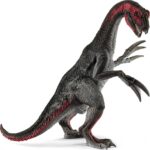The Therizinosaurus is widely recognized for its jaw-dropping claws, which can grow up to 3 feet (about 1 meter) in length. These long, sickle-shaped claws are one of the most striking features of this dinosaur and have intrigued paleontologists for decades. While it’s easy to assume that such large claws were designed for hunting or defense, the true purpose behind them remains a subject of debate. Let’s dive into the potential reasons why the Therizinosaurus evolved such long and sharp claws.
1. To Reach High Vegetation
One of the most widely accepted theories about the large claws of the Therizinosaurus is that they were used to help it reach high vegetation. Unlike many other theropods, which were carnivores, the Therizinosaurus was a herbivore. It is believed that its long claws allowed it to grasp and strip leaves from tall trees or shrubs. The claws would have acted almost like a “tool,” helping the dinosaur to pull down branches or swipe at high-growing plants that were otherwise inaccessible to many other herbivores of its time.
This adaptation suggests that Therizinosaurus was highly specialized to feed in a niche that other dinosaurs couldn’t. It may have fed on ferns, cycads, and other plant species that grew in the forested environments it inhabited during the Late Cretaceous period.
2. For Defense Against Predators
Although the Therizinosaurus was not a carnivore, its large claws may also have served as an effective defense mechanism. These enormous claws would have been formidable weapons when it came to warding off predators. The sight of such long, sharp claws would have been a clear deterrent to any potential threats, and in the event of an attack, the Therizinosaurus could have used its claws to swipe at or injure predators.
Given that the Therizinosaurus lived alongside large carnivores like the Velociraptor and the Tyrannosaurus rex, having such a powerful form of self-defense would have been crucial for survival. These claws may have helped the dinosaur establish dominance over other creatures in its ecosystem and protect itself from larger, more aggressive animals.
3. To Assist in Mating Displays or Social Interactions
Another intriguing theory is that the long claws of the Therizinosaurus may have played a role in social behavior, particularly during mating displays. While there is no direct evidence to support this, it’s possible that these claws were used in courtship rituals, similar to how modern animals use physical traits to attract mates.
Large, exaggerated features are often used by animals to demonstrate strength or dominance, and it’s conceivable that the Therizinosaurus employed its claws in a similar fashion. The claws may have been displayed to attract mates or intimidate rivals, much like how peacocks use their elaborate tail feathers for display purposes.
4. For Foraging and Feeding on Hard-to-Reach Food Sources
Beyond simply reaching high branches, the claws may have been useful in foraging for more specialized or hard-to-reach food sources. In the dense forests where Therizinosaurus likely roamed, there could have been a variety of plant life growing in difficult-to-reach locations, such as thick brush or dense, tangled vegetation.
The long claws could have allowed the Therizinosaurus to maneuver through such environments with ease, swiping or pulling apart dense vegetation to access hidden or less competitive food sources. This could have helped the dinosaur survive in ecosystems where other herbivores struggled to reach food that required a longer reach.
5. Evolutionary Quirk or Trait of the Theropod Family?
It’s also possible that the long claws of the Therizinosaurus were simply a result of evolutionary experimentation. Many dinosaurs, particularly theropods, evolved in unique ways that led to some remarkable physical features. The development of such large claws could have been an evolutionary quirk, a feature that arose and was maintained because it didn’t hinder the animal’s survival. Over time, these massive claws may have been further refined, eventually becoming one of the most defining characteristics of the species.
This theory is supported by the fact that Therizinosaurus was a distant relative of other theropod dinosaurs that had significantly smaller claws. These long claws may have simply been a distinctive trait that became more pronounced in the course of evolution, adapting to the specific environmental pressures and ecological niches that Therizinosaurus occupied.
6. Possibly Used in Interaction with Other Therizinosaurus Individuals
The claws might have been used in interactions with others of the same species. If the Therizinosaurus was social, its claws could have been employed during conflicts over territory, food, or mates. Territorial disputes between large herbivores often involve displays of strength, and the Therizinosaurus’ claws would have made it an imposing adversary in such encounters.
Alternatively, these claws could have been used for establishing dominance in a social hierarchy, with the largest, most impressive claws being a sign of superiority. Such behaviors are seen in modern-day animals, where physical traits are often used to assert dominance and influence social dynamics.
7. The Claws as a Multi-Purpose Tool
It’s possible that the long claws of the Therizinosaurus served multiple purposes throughout its life. They may have been used for feeding, defense, social interactions, and even environmental manipulation. The versatility of the claws may have allowed the Therizinosaurus to thrive in a variety of ecological settings, making it one of the most unique dinosaurs of its time.

Conclusion
The long and sharp claws of the Therizinosaurus were undoubtedly one of its most defining features. While the exact purpose of these claws remains speculative, they likely served a combination of functions, from helping the dinosaur feed on hard-to-reach plants to providing defense against predators and rivals. These extraordinary claws represent the remarkable ways in which animals can evolve unique traits to adapt to their environments, making the Therizinosaurus one of the most fascinating and enigmatic dinosaurs to ever exist.



